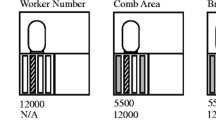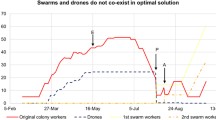Abstract
This study was built on the assumption that mother (queen) and workers (nurses) distribute their genes either through swarms (female biomass) or through the drones (male biomass). The swarming mood of the bee colonies was suppressed by an exactly defined increase in drone rearing. We studied the efficiency of reproductive investments (on genetic and energetic levels) of the mother and workers to the next generations. The equalization of fitness of the mother and nurses was achieved by a deliberately induced change in numerically stable sex asymmetry of a bee colony. A swarm was compensated with its energy demand and a volume ratio of distributed genetic information. The newly introduced term “reproductive investment complex” (RIC) includes the reproductive potential of the mother and reproductive energy of workers into care for the mother and for the brood. The number of individuals of one sex was closely connected with the weight of individuals of the oppposite sex. The described method of suppression of swarming mood was successfully tested on 60 honey bee colonies over seven years (2003–2009). A number of beekeepers that were acquainted with this method confirmed the success.
Similar content being viewed by others
References
Boomsma J.J. & Franks N.R. 2006. Social insects: from selfish genes to self organisation and beyond. Trends Ecol. Evol. 21: 303–308. DOI: 10.1016/j.tree.2006.04.001
Boomsma J.J. & Ratnieks F.L.W. 1996. Paternity in eusocial Hymenoptera. Philos. Trans. R. Soc. Lond. B Biol. Sci. 351: 947–975. DOI: 10.1098/rstb.1996.0086
Crozier R.H. 2008 Advanced eusociality, kin selection and male haploidy. Austr. J. Entomol. 47: 2–8.
Dawkins R. 1976. The Selfish Gene. Oxford University Press, Oxford, 224 pp.
Dawkins R. 1982. The extended phenotype. The gene as the unit of selection. W. H. Freeman and comp. Oxford, 307 pp.
Fefferman N.H. & Starks P.T. 2006. A modeling approach to swarming in honey bees (Apis mellifera). Insectes Sociaux 53: 37–45.
Ferrari S., Silva M., Guarino M. & Berckmans D. 2008. Monitoring of swarming sounds in bee hives for early detection of the swarming period. Comput. Electron. Agric. 64: 72–77.
Gencer H.V. & Firatli C. 2005. Reproductive and morphological comparisons of drones reared in quenright and laying worker colonies. J. Apic. Res. 44: 163–167.
Haberl M. & Tautz D. 1999. Paternity and maternity frequencies in Apis mellifera sicula. Insectes Sociaux 46: 137–145.
Hamilton W.D. 1964. The genetical evolution of social behaviour I and II. J. Theor. Biol. 7: 1–52.
Hölldobler B. & Wilson E.O. 1995. Journey to the Ants: A Story of Scientific Exploration. Harvard University Press, Cambridge, Massachusetts, 198 pp.
Liebig G. 1998. Einfacht Imkern. Eigenverlag, Stuttgart, 210 pp.
Liebig J., Peeters C. & Hölldobler B. 1999. Worker policing limits the number of reproductives in a ponerine ant. Proc. R. Soc. Lond. B Biol. Sci. 266: 1865–1870. DOI: 10.1098/rspb.1999.0858
Lin C.C., Chen T.W. & Lai C.C. 2003. The economics of honey bee swarming. Regional Science and Urban Economics 33: 581–594.
Linhart R. & Bičík V. 2007. Med pomáhají tvořit i trubci [Even drones help to create honey]. Včelařství 5: 125–126.
Linhart R., Bičík V. & Vagera J. 2007. Současná a nově navržená opatření proti rojení včely medonosné [Present and newly proposed measures against swarming of honey bee]. Včelařství 10: 1–16.
Montague C.C. & Oldroyd B.P. 1998. The evolution of worker sterility in honey bees: An investigation into a behavioral mutant causing failure of worker policing. Evolution 52: 1408–1415.
Neumann P. & Moritz R.F.A. 2000. Testing genetic variance hypotheses for the evolution of polyandry in the honey bee (Apis mellifera L.). Insectes Sociaux 47: 271–279.
Normark B.B. 2006. Perspektive maternal kin groups and the origins of asymetric genetic systems — genomic imprinting, haplodiploidy, and parthenogenesis. Evolution 60: 631–642.
Oldroyd B.P., Rinderer T.E. & Schwenke J.R. 1994. Subfamily recognition and task specialization in honey bees (Apis mellifera L.) (Hymenoptera, Apidae). Behav. Ecol. Sociobiol. 34: 169–173. DOI: 10.1007/BF00167741
Přidal A. & Čermak K. 2003. O rojivosti včel [On swarming of honey bees]. Včelařství 56: 112–115.
Rinderer T.E., Stelzer J.A., Oldroyd B.P. & Tingek S. 1998. Levels of polyandry and intracolonial genetic relationships in Apis koschevnikovi. J. Apic. Res. 37: 281–287.
Santomauro G., Oldham N.J., Boland W. & Engels W. 2004. Canibalism of diploid drone larvae in the honey bee (Apis mellifera) is released by odd pattern of cuticular substances. J. Apic. Res. 43: 69–74.
Tarpy D.R., Gilley D.C. & Seeley T.D. 2004. Levels of selection in social insects: a review of conflict and cooperation during honey bee (Apis mellifera) quen replacement. Behav. Ecol. Sociobiol. 55: 513–523. DOI: 10.1007/s00265-003-0738-5
Thompson G.J., Kucharski R., Maleszka R. & Oldroyd B.P. 2008. Genome — wide analysis of genes related to ovary activation in worker honey bees. Insect Mol. Biol. 17: 657–665. DOI: 10.1111/j.1365-2583.2008.00838.x
Visscher P.K. 1998. Colony integration and reproductive conflict in honey bees. Apidologie 29: 23–45.
Zeng Z.J. & Yan W.Y. 2004. Chinese research suggests drones stimulate worker foraging. Am. Bee J. 144: 232–233.
Author information
Authors and Affiliations
Corresponding author
Rights and permissions
About this article
Cite this article
Linhart, R., Bičík, V. & Vagera, J. The effect of induced changes in sexual asymmetry of honey bees (Apis mellifera) on swarming behaviour. Biologia 66, 535–542 (2011). https://doi.org/10.2478/s11756-011-0040-3
Received:
Accepted:
Published:
Issue Date:
DOI: https://doi.org/10.2478/s11756-011-0040-3




